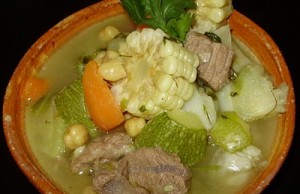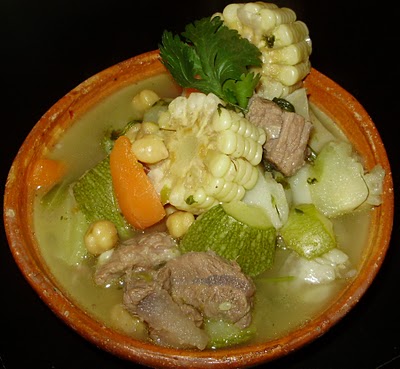At my grandmother’s, the famous “cocido de res Sonorense” (Sonoran cooked beef) was known as “puchero” (stew). She would greet us with this dish every time we visited her home on Calle de Xochicalco in Mexico City. My family always delighted in this, though personally I must admit I wasn’t much of a fan.
 “Monica,” my grandmother would scold, “How is this possible? This is from where you are from, and it’s beef, how can you not like it? Taste it, it came out really well.”
“Monica,” my grandmother would scold, “How is this possible? This is from where you are from, and it’s beef, how can you not like it? Taste it, it came out really well.”
It was always the same. We would eat this for the first two days because, in her excitement, she would always cook a lot. She really did prepare it well, but honestly I was always holding out for a milanesa, enchiladas, or tacos de canasta.
Now here in Puerto Peñasco, one day a friend of mine called up:
“It’s Tuesday, Cocido de Res day at Lolita’s; do you want some, because they’ll run out.”
“What is it?,” I asked naively.
“It’s like a beef broth with vegetables.”
I still didn’t understand the relationship of one with the other; I heard beef, broth, beef…I could leave the vegetables to the side if I didn’t like them.
“Ok,” I answered.
When my friend arrived at my home with a styrofoam cup, imagine my surprise to see this was the famous dish my family had baptized “puchero”!
I became a bit nostalgic; it was delicious (though not like my grandmother’s). While my friend lived here, she would go to Lolita’s religiously almost every Tuesday for their famous Cocido de Res.
The thing is, one cannot always go out to eat and/or buy enough for the whole family. Plus, what happens when it runs out and you’ve still got a hankering for it?
I decided to go to the phones for a recipe. This is the original, which my mother had jotted down in a notebook that no longer had a cover; it was as old as I. As she explained, everyone adds to or takes away whatever they seem fit based on personal taste. For example, she doesn’t add sweet potato or garbanzo, but she does throw in bone marrow to give the broth flavor, and then eats that on a salted tortilla.
Cocido de res
Ingredients:
½ kilo of aldilla (skirt steak)
½ kilo of sweet potato (there are those who substitute this with chayote)
1 oxtail
½ kilo potatoes
100 gr. Chorizo
¼ kilo green beans
2 cups garbanzo beans
4 zucchini
3 soft corn
3 pieces of squash
3 garlic gloves
1 handful of green cilantro
2 tomatillos
2 teaspoons salt
4 liter water
½ teaspoon pepper
Preparation:
Soak the garbanzo beans, then peel
Wash and cube beef (not too small)
Separate corn and clean, cut into segments (three or four depending on length)
Place beef in water (cubed pieces, oxtail, and (if you’re up for it) bone marrow) along with garlic and onion and cook to a boil.
Once pot begins to boil, remove foam from top and add garbanzo, corn, and salt.
Once cooked, add chorizo and remaining vegetables. Simmer on low until beef and vegetables are well cooked.
Ready! Serve hot. Ideal for the chilly evenings we’re having.
El famoso cocido de res sonorense
Por MoKa Hammeken
En casa de mi abuela se le conocía como “puchero” y nos recibía con él cada que íbamos de visita a su casa en la calle de Xochicalco en México, que mi familia se lo celebraba mucho pero que en lo personal no era muy fan.
-Mónica- me regañaba mi abuela – ¿Cómo es posible? Pero si es de tu tierra, y es de carne ¿cómo que no te gusta? Pruébalo, si me queda bien bueno-. Siempre era lo mismo; los primeros dos días comiendo eso porque en su entusiasmo hacía muchísimo. Si le quedaba muy bueno pero yo la verdad estaba esperando una milanesa, enchiladas o tacos de canasta.
Ya estando aquí en Peñasco, un día una amiga llamó por teléfono
-Es martes de cocido de res aquí en el Lolitas, ¿vas a querer? Por que se acaba-
Es como caldo de res con verduras-
Yo aún no conocía la relación de uno con el otro, escuché res, caldo, res, y las verduras las podía dejar de lado si no me gustaban mucho.
Bueno- contesté
Cuando llegó mi amiga con el vasito de unisel a mi casa, cual va siendo mi sorpresa, que era el famoso platillo bautizado por mi familia como “puchero”.
Me dio un poco de nostalgia, estaba sabroso, (aunque no como el de la abuela), y casi todos los martes mientras ella vivió aquí, iba religiosamente por su cocido de res al Lolitas.
El asunto es que uno no siempre puede salir a comer fuera y /o comprar para toda la familia, o también está el caso de que se acaba y ¿qué hace uno entonces con el antojo?
Decidí ir al teléfono por la receta. Esta es la original que mi madre tiene anotada en un cuaderno sin portadas tan viejo como yo, y como me explicó, ya cada quien le quita o le pone lo que crea conveniente y que le va a gustar, por ejemplo ella no le pone camote, ni garbanzo, pero le pone unos huesitos de tuétano, ahora si que para darle sabor al caldo y que luego se comen con tortilla y sal.
Cocido de res
Ingredientes:
1/2 kilo de aldilla
1/2 kilo de camote (hay quien lo sustituye por chayote)
1 colita de res
1/2 kilo de papas
100 gr. de chorizo
1/4 kilo de ejotes tiernos
2 tazas de garbanzo
4 calabacitas
3 elotes tiernos
3 pedazos de calabaza
3 dientes de ajo
1 manojo de cilantro verde
2 tomates
2 cucharaditas de sal
4 litros de agua
1/2 cucharadita de pimienta
Preparación:
El garbanzo se pone a remojar, luego se le quitan los hollejos (piel delgada de algunos frutos y legumbres).
Se lavan las carnes y se parten en cuadritos (no muy pequeños).
Por otro lado los elotes se limpian y se parten en trozos (tres o cuatro dependiendo del largo).
Se pone a cocer en el agua las carnes (los cuadritos, la cola y si se animaron el tuétano) junto con el ajo y la cebolla.
Cuando empieza a hervir se le quita la espuma y se le agregan el garbanzo, los elotes y la sal.
Cuando ya estén casi cocidos se le añaden el chorizo y demás verduras, y se deja hervir a fuego lento hasta que la carne y todo esté bien cocid
¡Y listo! Se sirve bien caliente. Ideal para ese frío rico que se siente luego por las tardes.

